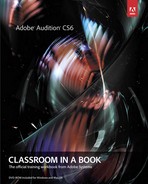6. Mastering
Mastering is the stage between mixing and distribution. By tasteful application of EQ, dynamics, waveform editing, widening, and other techniques, you can shape a piece of music into a refined audio experience that’s ready for distribution or posting online.
Mastering basics
Mastering is the process that occurs after mixing but before distribution. It’s where you add any final edits or enhancements (equalization, dynamics, fade in or out, etc.) to a stereo or surround mixed file. With album projects (whether a CD or collection of music posted online), mastering also involves determining the correct order of the songs in the album (“sequencing” the songs) and matching their levels and timbres for a cohesive listening experience.
As the final link in the music production chain, mastering can make or break a project. As a result, people often hand off projects to veteran mastering engineers, not just for their technical expertise, but to enlist a fresh, objective set of ears.
However, if your goal with mastering is simply to make a good mix better, Audition provides the tools required for professional-level mastering. The more you work with mastering, the more your skills will improve. But it can’t be emphasized enough that the most important mastering tool is a good set of ears that can analyze where a piece of music is deficient, coupled with the technical expertise of knowing what processing will compensate for those deficiencies.
In addition, remember that ideally the purpose of mastering is not to salvage a recording, but to enhance an already superb mix. If there’s a problem with the mix, remix the tune; don’t count on mastering to solve the problem.
In Lesson 4, “Signal Processing,” you learned how to do basic mastering with the mastering suite of effects in the Special menu. This lesson takes a more “component” approach by using individual effects, which are presented in the order in which you would typically apply these effects (equalization, dynamics, ambience, stereo imaging), and waveform “touchup.” Note that sometimes touching up the waveform occurs first if there are known problems that need to be fixed, such as a portion of the track is too quiet and needs to be raised in level with the Amplify effect.
Step 1: equalization
Usually, the first step of mastering involves adjusting equalization to create a pleasing tonal balance.
1. With Audition open to the Waveform Editor, choose File > Open, navigate to the Lesson06 folder, and open the file KeepTheFunk.wav.
2. In the Effects Rack, click insert 1’s right arrow and choose Filter and EQ > Parametric Equalizer.
3. If necessary, choose the Default preset from the Presets drop-down menu, and then select the 30dB Range radio button in the lower-right corner.
4. Click the Transport Play button and listen. The music sounds a little “muddy” in the low frequencies and lacks crispness in the highs. Loop the file by clicking the Transport’s loop button so it keeps playing while you make the following adjustments.
5. One way to identify problem areas is to boost a parametric stage’s Gain, sweep its Frequency, and listen to whether any frequencies jump out as excessive. So, click the Band 2 box, drag it all way up to +15dB, and drag the box left and right. Note that the sound is “tubby” around 150Hz.
6. Drag the Band 2 box down to around -5dB at around 150Hz. Note how this tightens up the low end. The difference is subtle, but often mastering is about the cumulative effect of multiple subtle changes.
7. The kick drum seems like it should be stronger and have more of a deep “thud” for this kind of music; use Band 1 to dial in the drum’s frequency and add a narrow boost. Set Band 1’s Q to 8, and drag the Band 1 box up to +15dB. Sweep the Frequency back and forth between 20 and 100Hz, and note that the kick really stands out around 45Hz.
8. Bring the Band 1 level back down to around 5-6dB so the kick isn’t too prominent.
9. The hi-hat and cymbals seem kind of dull, but increasing the high-frequency response can improve that. Set Band 4’s Q to 1.5, set Frequency to 8kHz, and drag the Band 4 box up to around +2dB.
10. Toggle the power state button again for comparison. Note that in the screen shot, unused bands have been turned off for clarity. Keep Audition open for the next lesson.
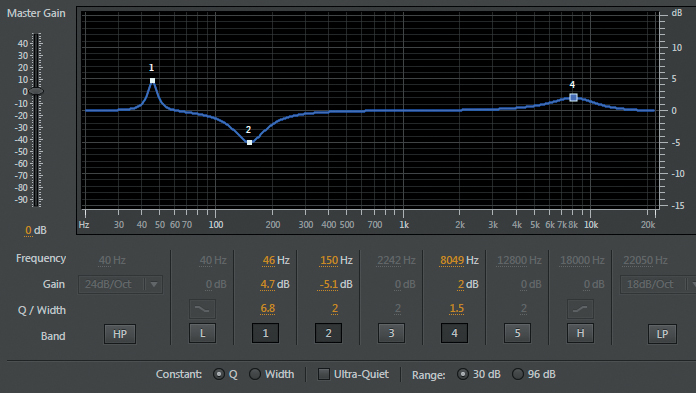
Step 2: dynamics
Dynamics processing can make a piece of music “jump out” of the speakers because it acquires more punch and makes low-level sounds louder. This can also help the music overcome background noises found in many different listening environments. To avoid listener fatigue, you don’t want to add too much processing and kill the dynamics, but some processing can produce a nice, lively lift.
This lesson uses the Multiband Compressor to control dynamics. In addition to offering compression in four frequency bands, there’s an overall output limiter.
1. In the Effects Rack, click insert 4’s right arrow and choose Amplitude and Compression > Multiband Compressor. (The reason for choosing insert 4 is because you’ll want to add some effects later between the EQ and dynamics.)
Note
Dynamics is usually the last processor in a mastering chain because it sets the maximum allowable level. Adding effects afterward could increase or decrease the overall level.
2. Choose the Pop Master preset from the Presets menu to give the music much more apparent loudness.
3. If you listen for a while, you’ll hear that the dynamics have been reduced dramatically—in fact, too much. To restore some dynamics, set each band’s Threshold parameter to -18.0dB.
Note
The meters to the immediate right of each band’s Threshold slider (whose position follows the numeric Threshold field) indicate the amount of compression. The further down the red “virtual LED” goes, the more compression is being applied.
4. Click in the limiter’s Threshold field and drag down to -20dB. The sound becomes overly limited, squashed, and uneven. Now drag up to 0. No limiting is being applied, and the sound lacks “punch.” Drag down to a good compromise setting between these two extremes, like -8.0dB.
5. Toggle the Effects Rack’s power state to compare the sound with and without the EQ and Multiband Compressor. The processed sound is fuller, tighter, more distinct, and louder. Also note that the Multiband Dynamics has emphasized the EQ changes made previously.
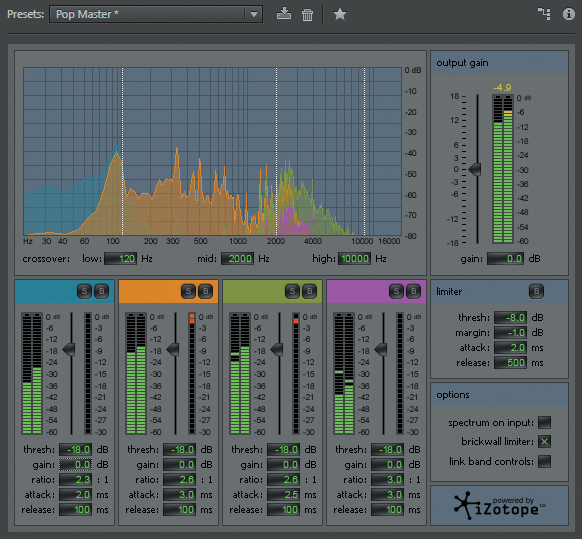
Step 3: ambience
Although reverb is seldom added during mastering, the music seems a little “dry.” So, you’ll add some ambience to give the illusion of the music being played in an acoustic space.
1. In the Effects Rack, click insert 2’s right arrow and choose Reverb > Studio Reverb.
Tip
With albums that contain tracks recorded at different times or in different studios, sometimes adding a subtle overall ambience produces a more cohesive feeling.
2. Choose the Room Ambience 1 preset from the Presets menu. You’ll need to stop the Transport to choose a preset. After choosing the preset, click the Transport Play button.
Note
The Studio Reverb trades off sound quality for real-time adjustment. For critical applications, one of the other reverbs is preferable, but for learning how reverb affects the sound, the Studio Reverb is a better choice due to its immediacy in changing settings.
3. Set the Dry slider to 0 and the Wet slider to 40% so it’s easy to hear the results of any edits.
4. Set Decay to 500ms, Early Reflections to 20%, Width to 100, High Frequency Cut to 6000Hz, Low Frequency Cut to 100Hz, and both Damping and Diffusion to 100%.
5. Adjust the blend of Dry and Wet signals. Set Dry to 90% and Wet to 50%.
6. Toggle the Reverb’s power state; you won’t hear much difference unless you listen very carefully, because this adds just a tiny bit of “spice.” The added ambience is most noticeable when the drums hit by themselves.

Step 4: stereo imaging
As with reverb, stereo imaging isn’t added often, but it’s appropriate for this particular lesson. Stereo imaging stretches the stereo image so the left channel moves more to the left, and the right channel moves more to the right. In this lesson, increasing the stereo image helps separate the two guitars in the opposite channels even more.
1. In the Effects Rack, click insert 3’s right arrow and choose Special > Mastering. Only the Widener will be used.
2. If necessary, choose the Default preset from the Presets menu.
3. Set the Widener slider to 85%.
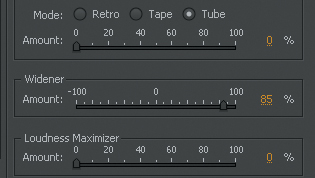
4. Toggle the Effects Rack’s power state to compare the sound with and without the various mastering processors—the results speak for themselves. Also, try turning the power state on and off for the individual processors to hear each processor’s overall contribution to the sound.
Step 5: “push” the drum hits; then apply the changes
Four drum hits happen between 23.25 and 24 seconds. You’ll boost them just a bit to give them more emphasis.
1. Click the Transport Stop button. Select the four hits (zoom in if necessary) and add +3.9dB of gain with the HUD (heads-up display).
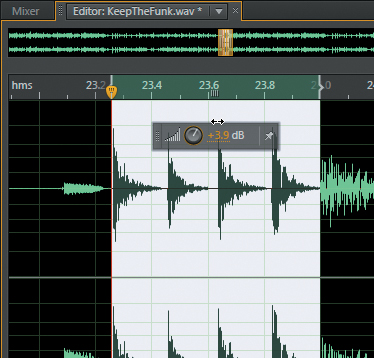
Note
Making edits to the waveform can be done prior to adding effects or after adding effects if a particular issue doesn’t become obvious until after you’ve applied effects that change the overall sound in a subtle, or even dramatic, way.
Note
The Apply function resets all effects to their default value. If you don’t like the results of using Apply, choose Edit > Undo to restore the effects and the settings you edited.
Note
It can take years to become good at the art and science of mastering, especially if the file has problems that need to be fixed. Nonetheless, most mastering simply revolves around EQ, dynamics, and some selected other processors.
2. Play the file to hear the result of boosting these four drum hits.
3. You’ll apply all these effects to make them a permanent part of the file, which will also redraw the waveform to show the changes caused by mastering. In the Effects Rack, choose Entire File from the Process drop-down menu.
4. Click Apply. Audition applies the result of all the effects to the file and removes the effects from the Effects Rack.
Review questions
1. At what stage of the music production process does mastering occur?
2. Is mastering only about optimizing individual tracks?
3. What are the most essential processors used in mastering?
4. Is adding ambience recommended when mastering?
5. What is the main disadvantage of excessive dynamics compression?
Review answers
1. Mastering occurs after mixing but before music distribution.
2. With album projects, mastering also sequences the songs in the correct order and aims for sonic consistency from track to track.
3. Typically, EQ and dynamics processors are the main effects used in the mastering process.
4. No. Normally ambience is added during the mixing process but can sometimes improve the sound when added while mastering.
5. The main disadvantage is a lack of dynamics, which can lead to listener fatigue because there are no significant variations between loud and soft passages.
